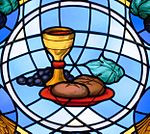Eucharist in Lutheranism
| Part of a series on the |
| Eucharist |
|---|
 |
Eucharist in the Lutheran Church refers to the celebration of the Last Supper, as seen in the Divine Service. The Sacrament of the Altar is a devotional term used in the Lutheran Church to refer the Eucharist (the true Body and Blood of Christ).
This article deals mainly with the practices and beliefs surrounding the Eucharist as practiced by Lutheran denominations which identify with Lutheran Orthodoxy. Although there is agreement among most Lutheran branches on the core meaning of the Eucharist, there is also a significant divide between conservative and liberal beliefs.
Beliefs
As Martin Luther wrote in his Small Catechism, Lutherans believe that Christ's true Body and Blood are received in the sacrament, but the Bread and Wine are also present, and rejecting the Catholic teaching of transubstantiation. Also, the catechism states that whoever receives the sacrament will also receive forgiveness, life, and salvation[1]. Lutherans sometimes use the terms "in, with and under the forms of consecrated bread and wine" and "sacramental union" to distinguish their understanding of the Lord's Supper from those of the Reformed and other traditions.
Confirmation
In order to receive the sacrament a person must take confirmation classes taught by the pastor of the church. The classes teach the meaning of the sacramental union and Lutheran eucharistic theology as well as the Ten Commandments, Apostles' Creed, Lord's Prayer, Holy Baptism, and The Office of the Keys & Confession.
Liturgy
The Service of the Sacrament in the Divine Service is as follows:[2]
Pastor: The Lord be with you.
People: And with thy spirit.
Pastor: Lift up your hearts.
People: We lift them up unto the Lord.
Pastor: Let us give thanks unto the Lord our God.
People: It is meet and right so to do.
Next is the Common Preface, followed by the Sanctus.
Holy, holy, holy Lord,
God of Sabbath,
heaven and earth are full of Thy glory.
Hosanna, Hosanna, Hosanna in the highest.
Blessed is he, blessed is he, blessed is he that cometh in the name of the Lord.
Hosanna in the highest.
Next the Eucharist Prayer is said by the pastor, followed by the Lord's Prayer, then the Words of Institution, which are chanted next.
Our Lord Jesus Christ, on the night when he was betrayed, took the bread, and when he had given thanks, he broke it and gave it to his disciples and said, 'Take; eat; this is my body which is given for you. This do in remembrance of me.' In the same way he also took the cup after the supper, and when he had given thanks, he gave it to them saying, 'Drink of it, all of you. This cup is the New Testament in my blood, shed for you for the forgiveness of sins. This do, as often as you drink it, in remembrance of me.
At the end of the Words of Institution, the elements are elevated, and the Pax Domini is chanted.
Pastor: The Peace of the Lord be with you always. People: And also with you.
The Agnus Dei follows.
O Christ thou Lamb of God, that takest away the sin of the world, have mercy upon us.
O Christ thou Lamb of God, that takest away the sin of the world, have mercy upon us.
O Christ thou Lamb of God, that takest away the sin of the world, grant us thy peace. Amen.
The Distribution is next, first the Pastor gives communion to those who are assisting him, such as the Elders and Acolytes. Next, in the same manner as the Catholic Church, the Pastor, Elders, and Acolytes line up, with the Pastor in the center, holding the Bread, the Elders on either side of him, holding the Chalices. When one receives the Bread, the Pastor will say "The True Body of Christ, given for you". When one receives the Wine the Elder says "The Blood of Christ, Shed for you". When everyone has communed and returned to their seat, the Elder gives the Pastor communion. After that, the Pastor says "Now may this True Body and Blood of our Lord and Savior Jesus Christ strengthen and preserve us in the True Faith, until life everlasting, depart with His joy and with His peace. You are forgiven. Amen." The congregation makes the sign of the cross at the end. Finally is the Nunc dimittis:
Lord, now lettest thou thy servant depart in peace
according to thy word.
For mine eyes have seen thy salvation,
Which thou hast prepared before the face of all people;
To be a light to lighten the Gentiles
and to be the glory of thy people Israel.
References
- ^ http://www.lcms.org/graphics/assets/media/LCMS/smallcatechism.pdf Luther's Small Catechism Online
- ^ Taken from the Lutheran Church of the Redeemer in Columbus, Georgia May 3rd, 2009

